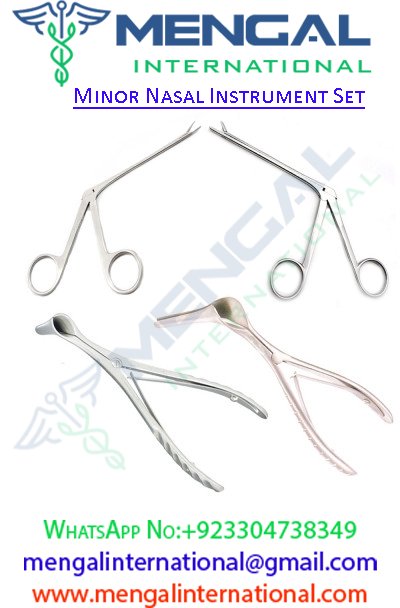Minor Nasal Instrument Set
The Minor Nasal Instrument Set is a collection of five different tools required for minor nasal surgical procedures. It includes different nasal speculums and forceps.
| Sr No | Item and size | Quantity |
| 1 | Vienna Nasal Specula Medium | 1 |
| 2 | Killian Nasal Specula 3″ Blades | 1 |
| 3 | Cottle Septum Specula 6″ 50mm | 1 |
| 4 | Noyes Alligator Forceps Serrated Shaft 5 1/2″ | 1 |
| 5 | Takahashi Ethmoid Forceps 4 1/2″ 2.5X10mm | 1 |
Our Minor Nasal Instrument Set has all instruments made of German stainless steel. They are resistant to rust and corrosion, and their surfaces are inert to many chemical reactions. Furthermore, all the tools in the set are :
• Ergonomically designed
• Autoclavable
• Reusable
• High tensile
Description
A minor nasal instrument set is a collection of specialized surgical tools used by otolaryngologists (ENT specialists) for procedures involving the nasal cavity and sinuses. These instruments are essential for both diagnostic examinations and minor surgical interventions aimed at treating various nasal conditions, such as nasal septum deviation, nasal polyps, sinusitis, and nasal trauma. Here’s a detailed overview of the components typically found in a minor nasal instrument set:
Components of a Minor Nasal Instrument Set:
- Nasal Specula:
- Nasal Speculum: Used to widen the nasal passages for better visualization and access during nasal examinations and procedures.
- Nasal Examination Instruments:
- Otoscopes: Instruments equipped with light sources and magnifying lenses used to examine the nasal cavity, including the septum and turbinates.
- Nasal Endoscopes: Flexible or rigid tubes with light sources and cameras used for detailed examination of the nasal passages and sinuses.
- Nasal Surgery Instruments:
- Nasal Septum Instruments: Instruments used for procedures involving the nasal septum, such as septoplasty (correction of deviated septum) and septal perforation repair.
- Septum Scissors: Used for cutting and trimming the nasal septum.
- Septum Forceps: Used for grasping and manipulating tissues during septal surgery.
- Nasal Polyp Instruments: Instruments used for the removal or treatment of nasal polyps, including polyp forceps and micro-debriders.
- Sinus Surgery Instruments: Instruments used for sinus surgeries, such as sinus rongeurs and curettes for tissue removal and sinus forceps for tissue manipulation.
- Nasal Packing Instruments: Instruments used to insert and remove nasal packing materials after nasal surgeries.
- Nasal Septum Instruments: Instruments used for procedures involving the nasal septum, such as septoplasty (correction of deviated septum) and septal perforation repair.
- Sinus Instruments:
- Sinus Rongeurs and Curettes: Instruments used for removing diseased tissue or bone within the sinuses.
- Sinus Forceps: Delicate forceps used for grasping and manipulating tissues within the sinuses during surgery.
- Surgical Drills and Power Instruments:
- ENT Drill System: Motorized drills used for precise bone work during procedures involving the nasal bones or sinuses.
- Powered Instruments: Includes various attachments and blades used for cutting, shaving, or removing bone and tissue.
- Miscellaneous Instruments:
- Suction Devices: Used for removing fluids, blood, and debris from the nasal cavity and sinuses during procedures.
- Sterile Drapes and Towels: Used to maintain a sterile field around the surgical site during procedures.
Procedure:
- Preparation: The patient is positioned appropriately, and local or general anesthesia is administered as required for the specific procedure.
- Incision and Access: An appropriate incision may be made in the nasal passages or sinuses to access the surgical site, depending on the procedure.
- Procedure Specific Steps:
- Examination: Using diagnostic instruments such as otoscopes or nasal endoscopes, the ENT specialist examines the nasal cavity and sinuses to assess the condition and plan the treatment.
- Surgical Intervention: Surgical instruments from the nasal instrument set are used to perform procedures such as septoplasty, polypectomy, or sinus surgery.
- Closure: After completing the surgical procedure, any incisions are closed using sutures or other closure methods. Nasal packing may be placed if necessary.
- Post-operative Care: The patient is monitored closely in the recovery room and then transferred to a hospital room or outpatient recovery area. Post-operative care includes pain management, monitoring for complications, and specific instructions for wound care and recovery.
Conclusion:
A minor nasal instrument set is essential for otolaryngologists performing diagnostic examinations and minor surgical procedures to treat various nasal conditions. These specialized instruments enable precise examination, diagnosis, and treatment of nasal and sinus disorders, ensuring optimal patient outcomes and recovery. Proper maintenance, sterilization, and organization of the nasal instrument set are crucial to uphold surgical standards and promote patient safety during nasal surgeries and procedures.







Reviews
There are no reviews yet.